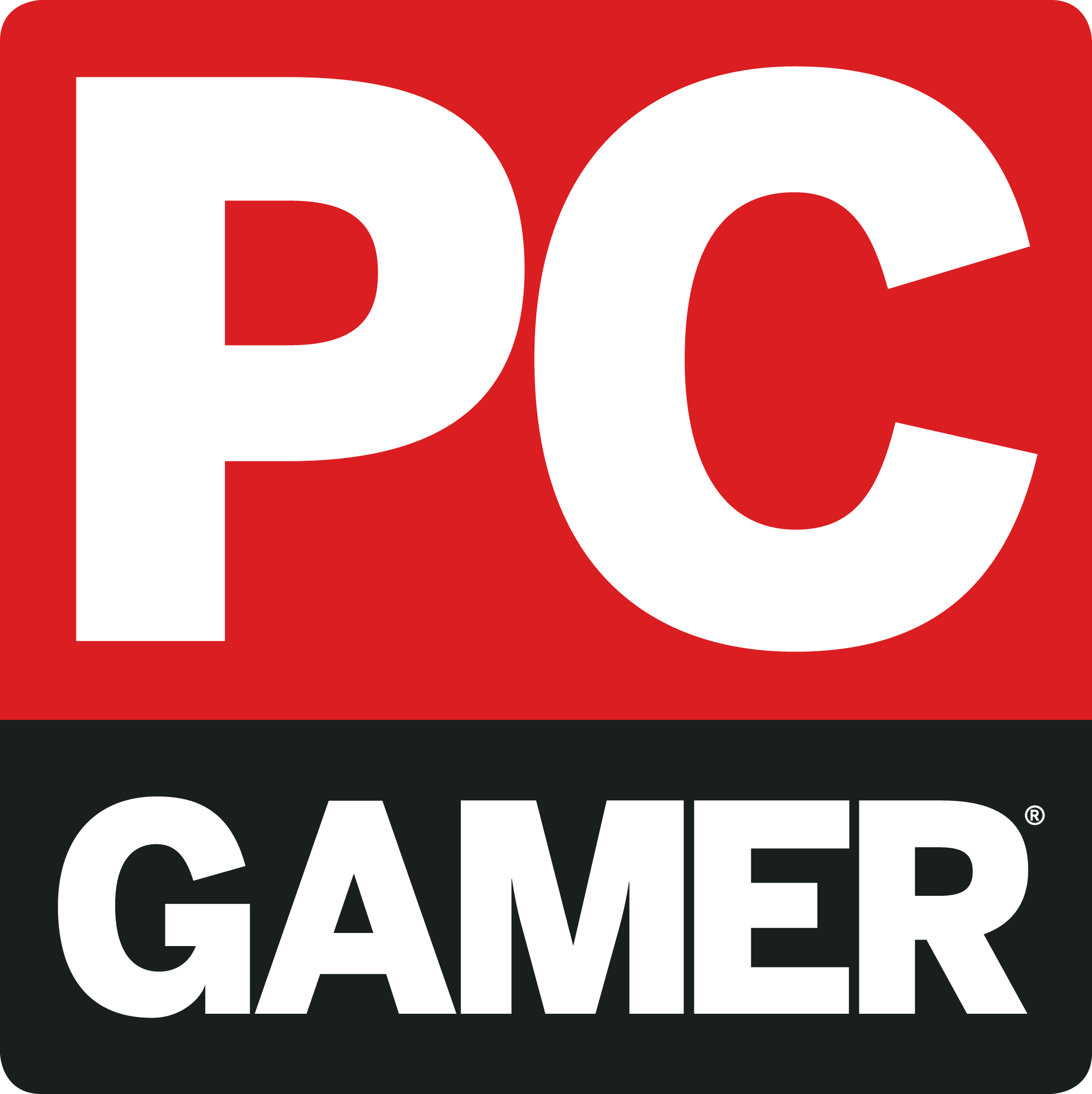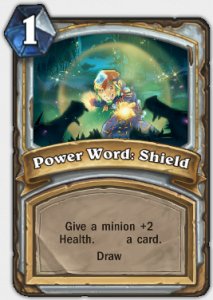
Power Word: Shield
Mana: 1
Crafting cost: N/A
Class: Priest
Rarity: Basic
Give a minion +2 Health. Draw a card.
VS: So, I love cantrips . Always have. Being able to draw an extra card is very important in many card games, since it essentially 'thins' your deck from the regular size. A smaller deck-size effectively means fewer cards waiting to be drawn, so there's less chance of getting bogged down by cards which are ineffective in the current match. Power Word: Shield is probably the best cantrip in Hearthstone because it's cheap and also has a respectable primary effect.
Health, in general, is better than attack, because a durable card will enable you to attack several times for greater combined damage than a single high-damage attack. Being able to score advantageous trades at the start can also often snowball the match in your favor. Even when drawn late this card still enables advantageous trades, or speeds up you drawing the key 'finisher' card that you need. As with Ancient of Lore , if this were a Neutral card, it would be run in a large amount of decks.
Keep up to date with the most important stories and the best deals, as picked by the PC Gamer team.
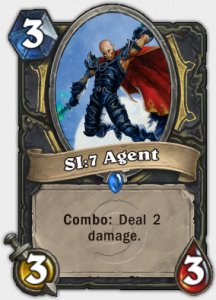
SI:7 Agent
Mana: 3
Attack: 3
Health: 3
Crafting cost: 100
Class: Rogue
Rarity: Rare
Combo: Deal 2 damage
VS: This card is insane, and a huge part of what makes the Rogue class so good in terms of 'Tempo'. Being able to kill almost any 1 or 2 drop card, and leave behind a decent 3/3 minion is crazy value. When we look at similar Neutral cards, the Ironforge Rifleman only deals 1 damage and loses out on 1 health and 1 attack. The Stormpike Commando costs 5 mana for the same damage, but has 1 less health, though it does have slightly more attack.
Now, of course SI:7 does have to played after another card in order to create the combo effect and deal its damage, which can occasionally be a problem, particularly when going first. However, with the plethora of cheap minions or spells that Rogue decks run, it's less of a worry. Oh, and Coin, Backstab , SI:7, SI:7, Backstab is the best possible starting hand of any class in Hearthstone. Being able to drop an SI:7 on the second turn is absolutely huge.
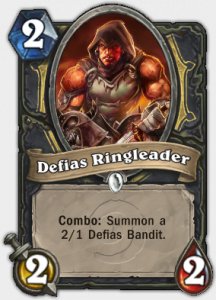
Defias Ringleader
Mana: 2
Attack: 2
Health: 2
Crafting cost: 40
Class: Rogue
Rarity: Common
Combo: Summon a 2/1 Defias Bandit.
TC: Here's another really fun early-game combo for Rogues to experiment with. Play the Ringleader after any other card and he'll summon a 2/1 Bandit. Next, use Shadowstep to return the Ringleader to your hand, where because he now costs 2 mana less, meaning you can play him again for free, and because the combo is still in effect you'll summon another Bandit.
So that's three minions on the board, and a total of 6/4 in terms of attack/health points. And if you use the coin and luckily draw the cards in your starting hand, you can actually play it on your first turn!
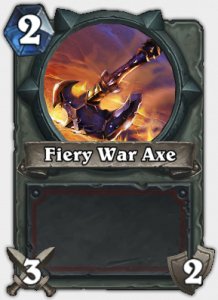
Fiery War Axe
Mana: 2
Attack: 3
Durability: 2
Crafting Cost: N/A
Class: Warrior
Rarity: Basic
VS: This card is the ol' reliable of the Warrior class. It's certainly not very flashy, all it does is kill 2 minions for 2 mana. Wait, excuse me? That's right, Fiery War Axe, like many weapons, is a machine which you can use to convert health into minion removal.
Early-game advantage is very important, so being able to remove even a couple of low cost creatures, like a River Crocolisk and a Stonetusk Boar , already gives you not only a card advantage (because one Fiery War Axe destroys two Cards), but also a trading advantage (because it takes 2 mana to remove 3 mana's worth of minions).
Much like Ancient of Lore for Druids, every single Warrior deck I have ever seen runs two of this card, and for understandable reasons: Reliability and Efficiency.
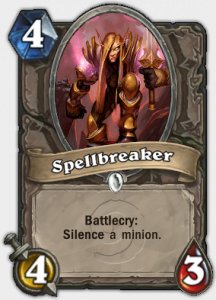
Spellbreaker
Mana: 4
Attack: 4
Health: 3
Crafting cost: 40
Class: Neutral
Rarity: Common
Battlecry: Silence a minion
JM: The Spellbreaker is like a beefier Ironbeak Owl , The Owl gives you a 2/1 minion for 2 mana, whereas the Spellbreaker is a 4/3 for 4... It's like one bonus point of health! Silence will be huge in the metagame likely to result from the cards released as part of the upcoming Curse Of Naxxramas adventure mode, because you can remove anything really tricky effects, like Baron Rivendare causing deathrattles to trigger twice, completely disrupting a player's strategy.
When the initial silencing battlecry is complete, you still have a pretty threatening minion on board, especially if he is hidden behind a taunt minion. On top of that, like the Owl, he's a common card, so he doesn't cost a lot to craft.
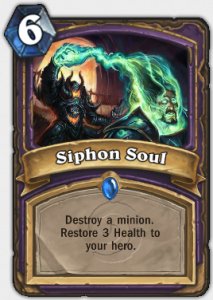
Siphon Soul
Mana: 6
Crafting cost: 100
Class: Warlock
Rarity: Rare
Destroy a minion. Restore 3 Health to your hero.
VS: I really like Siphon Soul. For only 1 mana more than Assassinate, you gain 3 health. Which is a fair price (3 points of healing ought to cost 1 mana, judging by Holy Light), but it's also a crucial card for Warlocks . The Life Tap ability means Warlocks can always convert health into Card Advantage, so Siphon Soul is a very flexible form of removal. 6 mana is also a relatively flexible price.
In the late game you can drop a 4 mana minion in the same turn, and there is generally a large surge in power between 3-mana and 4-mana cards. So, would Siphon Soul be a better card if it cost 7 mana and let you destroy a minion and regain 6 health? Well, it would certainly be run in Control Warlock decks, but its best combo play would be with Earthen Ring Farseer . Now, a 9 health swing is certainly handy, but imagine dropping a 0 mana Molten Giant , using Siphon Soul to kill an enemy minion, and then using Taunt on the Molten Giant with Defender of Argus. Boom!
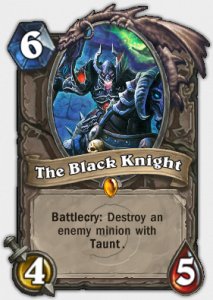
The Black Knight
Mana: 6
Attack: 4
Health: 5
Crafting cost: 1600
Class: Neutral
Rarity: Legendary
Battlecry: Destroy an enemy minion with Taunt
It's easy to see why players are regularly including this Legendary in all sorts of decks. The base stats are the same as our beloved Chillwind Yeti, but the extra 2 mana cost buys you instant death for a minion with taunt, regardless of how much health it has.
So, you get a very decent minion and an outstanding removal card rolled into one. Perfect for knocking a hole in your opponent's late-game defence – "Sayonara, Ironbark Protector! " – and leaving them open for the kill.
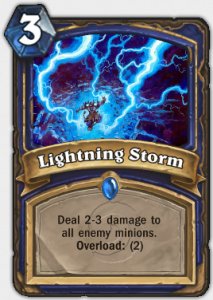
Lightning Storm
Mana: 3
Crafting cost: 100
Class: Shaman
Rarity: Rare
Deal 2-3 damage to all enemy minions. Overload: (2)
VS: The best standalone AoE spell in the game. At worst, this is like Consecrate for 1 more mana but playable a turn earlier. At best, it can be combined with +1 Spellpower for a 3-mana Flamestrike. Useable so early in the match, the Shaman can often insta-win against aggressive 'rush' decks like Murloc or even Zoo. There are a lot of differing opinions on Overload as a mechanic, personally I think of it as 'borrowing' mana from the next turn, so you can play a 5-mana card like Lightning Storm on the third turn, but you can only play 2-mana's worth of cards on the next turn.
Often the problem with Overload is that it leads to a very damaging tempo hit if your opponent can play 4 mana's worth of cards whilst you only play 2, your advantage slips away. However, AoE spells like Lightning Storm by their nature lead to a tempo gain since you can potentially kill 6 mana's worth of minions on turn 3, and possibly far more in later turns. In short: The spell's power cancels out any disadvantage.
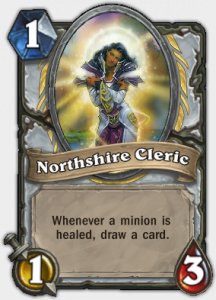
Northshire Cleric
Mana: 1
Attack: 1
Health: 3
Crafting cost: N/A
Class: Priest
Rarity: Basic
Whenever a minion is healed, draw a card
PW: This is an entirely selfish pick for this list because it was the card which caused my favourite Hearthstone victory of all time. Don't get me wrong, it's a good card anyway. It gives the Priest great draw power and synergises well with cards like Holy Nova and Circle of Healing . Perhaps a little too well sometimes.
Very early on I was playing against a Priest who decided not to end the game but do a spot of showboating. Instead of just going for the GG he decided to heal every one of his seven minions and drew seven cards. Except the draw power of having two Clerics had left the Priest's deck with only one card to draw. That meant thirteen hits of fatigue from drawing non-existent cards which works out at 91 damage to the Priest. A cautionary tale, to be sure, but one which left me DELIGHTED and victorious.
PC Gamer is the global authority on PC games—starting in 1993 with the magazine, and then in 2010 with this website you're currently reading. We have writers across the US, Canada, UK and Australia, who you can read about here.
